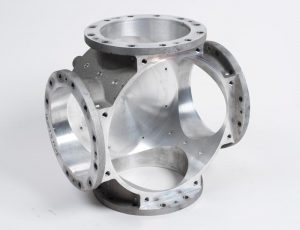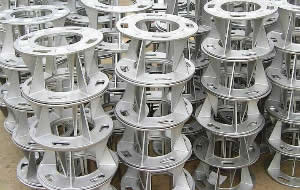Aluminum Casting Techniques: a Deep Dive Into Products and Methods for Success
Aluminum casting methods play a vital function in production. Numerous approaches exist, each matched to different applications and demands. Sand casting is favored for larger parts, while die casting is known for its precision in high-volume manufacturing. Financial investment casting provides thorough designs with exceptional finishes. Comprehending these differences can greatly impact task results. Precision aluminum casting. Selecting the appropriate approach is not constantly uncomplicated, leading to essential considerations that must be explored even more.
Recognizing Aluminum Casting: A Review
Aluminum casting is an essential manufacturing procedure utilized across numerous industries to create elaborate components with high precision. This technique entails putting molten aluminum right into a mold, allowing it to take the shape and strengthen of the desired component. The flexibility of aluminum, incorporated with its light-weight and corrosion-resistant properties, makes it an ideal option for applications in automotive, aerospace, and consumer items.
Different casting techniques exist, each suited to particular demands and task scales. Elements such as mold materials, cooling down prices, and the intricacy of the style play a considerable role in identifying the most efficient approach. Furthermore, the residential or commercial properties of the aluminum alloy used can influence the end product's surface, sturdiness, and stamina surface.
Recognizing the fundamentals of aluminum casting enables producers to enhance production procedures, minimize waste, and assurance top quality result, which is necessary in today's open market.
Sand Casting: Methods and Applications
Amongst the numerous methods utilized in aluminum casting, sand casting sticks out because of its flexibility and cost-effectiveness. This approach entails creating a mold from a mixture of sand and binder, which can be shaped to accommodate intricate layouts. As soon as the mold is ready, liquified aluminum is poured right into it, enabling elaborate attributes and information to be recorded.
Sand casting is especially valuable for generating huge parts and low-volume production runs, making it ideal for auto components, machinery parts, and imaginative sculptures. The method additionally accommodates a range of aluminum alloys, improving its flexibility in numerous applications. Furthermore, using sand as a mold product allows for easy improvement and reuse, adding to ecologically lasting methods. Accomplishing high dimensional accuracy can present obstacles, necessitating experienced craftsmanship and mindful control of the casting procedure. Generally, sand casting continues to be a fundamental approach in aluminum foundries worldwide.
Die Casting: Precision and Effectiveness
Die casting is a very effective technique of creating aluminum elements with extraordinary dimensional precision and surface finish. This process involves requiring molten aluminum right into a specifically machined mold and mildew under high pressure, which permits for complex designs and very little product waste. The rapid cooling of the alloy within the mold leads to a solidified part that often needs little to no extra machining.
Die casting is particularly beneficial for high-volume manufacturing runs, where uniformity and speed are vital. It sustains the development of intricate geometries, making it suitable for various applications, including auto, aerospace, and consumer goods.
Additionally, the procedure can suit various aluminum alloys, boosting the mechanical buildings of the finished products. With its capability to generate light-weight yet sturdy parts, die casting attracts attention as a recommended technique in contemporary production, supplying both precision and effectiveness in aluminum casting.
Financial Investment Casting: Detail and Intricacy
Financial investment casting, additionally understood as lost-wax casting, is a versatile and precise method for producing intricate aluminum parts. This strategy is specifically valued for its capacity to develop complex geometries and great details that are frequently unattainable via various other casting methods. The process begins with a wax pattern, which is coated in a ceramic covering. Once the covering sets, the wax is disappeared, leaving an in-depth mold and mildew try these out for aluminum pouring.
The advantages of financial investment casting consist of premium surface area coating and dimensional accuracy, reducing the need for extensive machining later. It is particularly useful for little to medium manufacturing runs where precision is important. This technique accommodates numerous aluminum alloys, improving its applicability throughout markets. Precision aluminum casting. Inevitably, investment casting stands out for its ability to deliver both aesthetic appeal and useful performance in aluminum parts, making it a favored choice for designers and designers seeking complicated services

Selecting the Right Approach for Your Project
Exactly how can one determine the most suitable aluminum casting approach for a certain job? The option process depends upon a number of important elements, consisting of the intricacy of the design, the wanted surface area finish, and production volume needs. For complex styles, investment casting typically confirms helpful because of its ability to capture fine information. On the other hand, sand casting might be chosen for larger, less complicated components, supplying cost-efficiency and flexibility in production.
In addition, considerations relating to resistances and mechanical homes of the last product are necessary. For high-performance components, die casting may be the most effective selection, as it offers remarkable dimensional accuracy and surface area top quality. On top of that, recognizing the product buildings and compatibility with the picked technique is very important for making certain the success of the task. Inevitably, a detailed analysis of these variables will certainly direct the decision-making process, leading to one of the most reliable aluminum casting technique for the specific task Get More Info handy.
Often Asked Questions
What Is the Ecological Influence of Aluminum Casting Approaches?

Exactly How Can I Boost the Surface Complete of Cast Aluminum?
To boost the surface area coating of actors aluminum, one can utilize techniques such as sandblasting, polishing, and applying coatings. Proper mold and mildew layout and temperature visit here level control likewise greatly enhance the final surface high quality of the actors item.
What Safety and security Precautions Should Be Taken Throughout Aluminum Casting?
During aluminum casting, essential safety and security precautions include using safety gear, guaranteeing appropriate air flow, making use of fire-resistant materials, preserving a secure range from liquified metal, and adhering to equipment security methods to stop injuries and mishaps.
Exactly how Do I Repair Usual Casting Flaws?
To repair typical casting flaws, one ought to check the mold and mildew for damage, assess the alloy composition, check putting temperature level, change cooling prices, and warranty correct airing vent to decrease air entrapment and boost casting top quality.
What Are the Prices Connected With Different Aluminum Casting Techniques?
The prices related to different aluminum casting techniques differ substantially, affected by variables such as product costs, production, labor, and equipment range. Budget factors to consider are important for picking one of the most suitable casting method for specific tasks.
Sand casting is preferred for larger components, while die casting is known for its precision in high-volume production. Among the numerous methods utilized in aluminum casting, sand casting stands out due to its versatility and cost-effectiveness. Die casting is an extremely efficient technique of creating aluminum components with remarkable dimensional accuracy and surface area coating. Financial investment casting, likewise understood as lost-wax casting, is a flexible and exact approach for producing complicated aluminum components. Exactly how can one establish the most suitable aluminum casting method for a particular job?